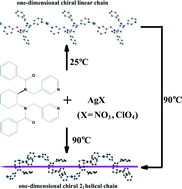Temperature-induced one-dimensional chiral Ag(i) linear chains and left-handed 21 helices: DFT studies, luminescence and SHG response†
Abstract
Two pairs of chiral coordination polymers, {{Ag[(1R,2R)-3-bcpb]}·X·H2O·CH3OH}n [X = NO3 (1a), ClO4 (1b)] and {{Ag[(1R,2R)-3-bcpb]}·X·3H2O}n [X = NO3 (2a), ClO4 (2b)] where (1R,2R)-3-bcpb = N,N′-((1R,2R)-cyclohexane-1,2-diyl)bis(N-(pyridin-3-ylmethyl)benzamide), have been synthesized with the same materials at 25 and 90 °C, respectively. 1a and 1b are 1D chiral linear chains, while 2a and 2b display left-handed 21 helical chains with dual chiral components, including the congenital chiral carbon centres and the acquired chirality of the single-handed helices. 1a and 1b can be transformed into 2a and 2b, respectively, by heating, while the reverse operations failed. The structural difference between 1a (1b) and 2a (2b) may be attributed to the different configurations of the ligand, which are highly influenced by the reaction temperature and can further be theoretically explained by DFT calculations. Luminescence studies revealed interesting emission bands. Circular dichroism spectra and second-harmonic generation efficiency measurements of the products have been investigated as well, which indicate their potential applications in chiral and nonlinear optics.


 Please wait while we load your content...
Please wait while we load your content...